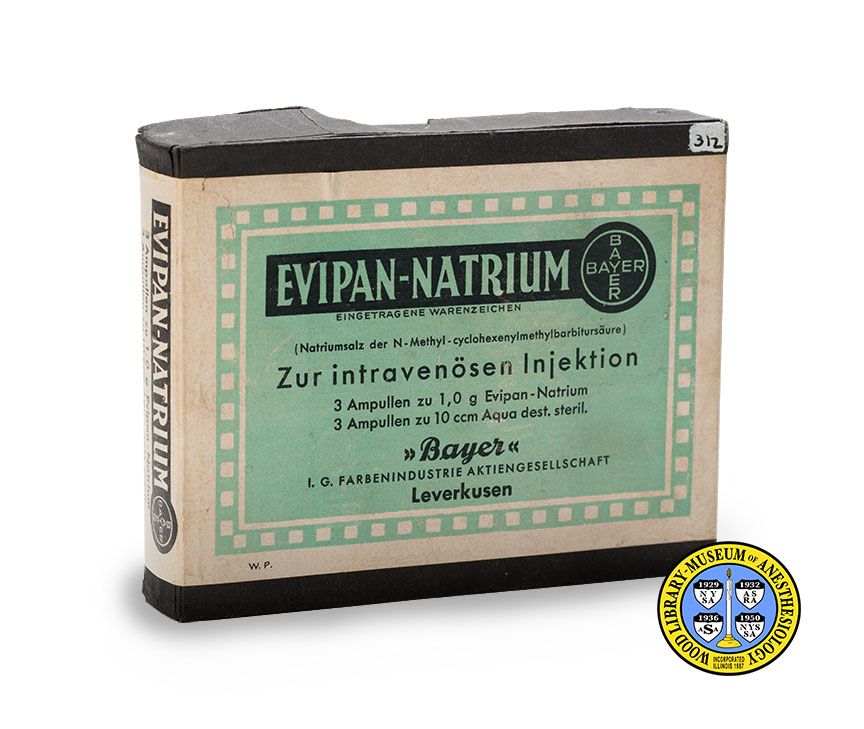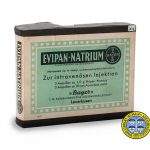Hexobarbital
Barbiturates are a class of hypnotic and sedative agents developed in the early 20th Century. Hexobarbital was prepared by the German pharmacologists Weese and Scharpf in 1932. It was one of the first barbiturate drugs used by anesthesiologists for induction (the beginning phase of general anesthesia). In Europe, the drug was sold by the German pharmaceutical giant, Bayer, under the name "Evipan". In the United States, it was marketed as "Evipal" by Winthrop Chemical Company, a Bayer affiliate. This box was captured by U. S. forces during WWII, at the fall of Cherbourg in July, 1944. It was later donated to the WLM by Captain Harry Meyer, M.D.
Catalog Record: Hexobarbital
Access Key: almj
Accession No.: 312
Title: Evipan-Natrium / Bayer.
Corporate Author: Bayer.
Title variation: Alt Title
Title: Hexobarbital (“Evipan”).
Publisher: Leverkusen : Bayer, I. G. Farbenindustrie Aktiengesellschaft, [between 1940 and 1944].
Physical Descript: 1 drug package : paper, paperboard ; 2.5 x 12 x 9.5 cm.
Subject: Drug Packaging.
Subject: Barbiturates.
Subject: Hexobarbital – history.
Note Type: General
Notes: The date range for the possible year of manufacture of this package of
Evipan-Natrium is based on the recorded provenance – abandoned by retreating
German soldiers and collected by Captain Marry Meyer in July of 1944. The
date range could change if documentation indicates that it should be
corrected.
Note Type: Citation
Notes: Corssen G, Reves JG, Stanley TH. The barbiturates. In: Intravenous Anesthesia
and Analgesia. Philadelphia: Lea & Febiger; 1988:67.
Note Type: Citation
Notes: Dundee JW, McInroy DA. The history of barbiturates. Anaesthesia.
1982;37(7):726-734. https://onlinelibrary.wiley.com/doi/10.1111/j.1365-2044.
1982.tb01310.x/abstract. Accessed April 4, 2015.
Note Type: Citation
Notes: Harry Meyer donor file. Located at: Located at: Wood Library-Museum of
Anesthesiology, Schaumburg, Illinois.
Note Type: Physical Description
Notes: One empty paperboard box for packaging of 3 ampules of Evipan-Natrium powder
and 3 ampules of sterile water; The box is black; covering a large portion of
the box is a white and green label with black print; The text on the portion
of the label that is on the top of the box is marked with the following text:
EVIPAN-NATRIUM [this is followed by the cross-like Bayer logo, and a new
line] EINGETRAGENE WARENZEICHEN [new line] (Natriumsalz der
N-Methyl-cyclohexenylmethylbarbitursäure) [new line] Zur intravenösen
Injektion [new line] 3 Ampullen zu 1.0 g Evipan-Natrium [new line] 3 Ampullen
zu 10 ccm Aqua dest. steril [new line] Bayer [new line] Bayer [new line] I. G
FARBENINDUSTRIE AKTIENGESELLSCHAFT [new line] Leverkusen; Hand painted in
the upper right corner of the top of the box is, “312”; The text printed on
the label that runs to the left and right sides is, “EVIPAN-NATRIUM [this is
followed by the cross-like Bayer logo, and a new line] 3 Ampullen zu 1.0 g
Evipan-Natrium [new line] 3 Ampullen zu 10 ccm Aqua dest. steril; On the
bottom of the box is a label that is folded and worn; Printed on the label is
the following text: “Evipan-Natr. 3 x 1,o g [new line] Aqua dest. 3 x 10
ccm [new line] 22180 1G/0723.
Note Type: Reproduction
Notes: Photographed by Mr. Steve Donisch November 12, 2014.
Note Type: Acquisition
Notes: Donated to the WLM by anesthesiologist Captain Harry Meyer, MD, (1919-1977).
Note Type: Historical
Notes: Evipan was a brand name for the barbiturate hexobarbital. Barbiturates are a
group of drugs that slow down, or depress, the activity of the nervous system
including the brain.
Barbituric acid, the compound from which barbiturates are derived, was first
synthesized by the German chemist Adolf von Baeyer in 1864. The first
derivative of barbituric acid used to produce sedation was described in 1903.
Barbiturates that could be administered intravenously were introduced in the
1920s. These had exceedingly long lasting effects. In 1932, when the
shorter-acting hexobarbital was introduced in Germany it quickly became a
popular drug for inducing anesthesia. Its use spread worldwide. A few years
later, after the introduction of thiopental, the use of hexobarbital began to
wane. (See catalog records aiwh, aiwg, aivy, and the WLM webpage for
hexobarbital at https://www.woodlibrarymuseum.org/museum/item/70/thiopental.)
This German-manufactured package of Evipan was captured during World War II
at the fall of Cherbourg, France in July, 1944. It was donated to the WLM by
anesthesiologist Captain Harry Meyer, MD, (1919-1977). In the U.S., the brand
name for hexobarbital was Evipal.
Note Type: Publication
Notes: Defalque RJ, Wright AJ. Anesthesia in the Wehrmacht (1939-1945). In: Fink BR,
ed. The History of Anesthesia: Third International Symposium. Park Ridge,
Illinois: Wood Library-Museum of Anesthesiology; 1992:143-146.
Note Type: Exhibition
Notes: Exhibited at the National World War II Museum in New Orleans, October, 2014.


